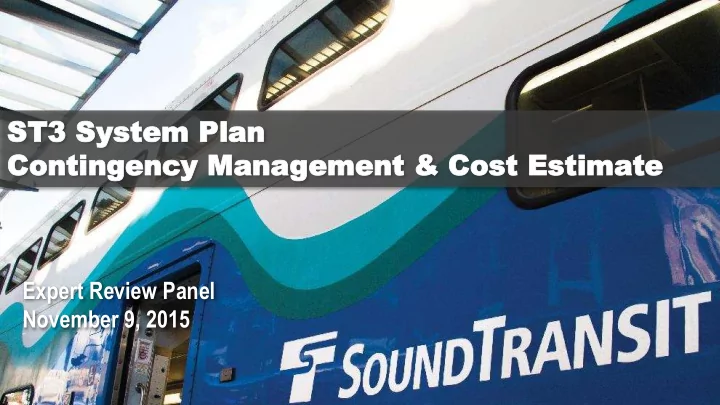

ST3 ST3 Sys Syste tem m Plan Plan Con Conting tingen ency y Man Manage gemen ment t & & Cos Cost t Est Estima imate te Expert Review Panel November 9, 2015
Contingency Management • Sound Transit actively manages project budget contingency and reports on status at both contract and project levels. • Project Control Policy & Procedures PCPP- 12 establishes standard practices, assigns responsibilities and provides guidelines to management of project contingency ( refer to Attachment 1 ) 2
Purpose of Contingency • Contingency is a budget allowance to address uncertainty and risk associated with the delivery of a given scope of work • Contingency provides the mechanism to manage the variance between estimates and actual project cost. • Use of contingency is inevitable, and it demonstrates good management & standard business/industry practice. 3
Establishment of Project Contingency • Contingency is established during the development of capital project budgets. • Contingencies are refined and updated at different stages of project development. 4
Contingency Matrix The matrix below indicates a guide for acceptable contingency ranges by estimate level. The matrix incorporates best practices from AACEI, ASPE, and FTA. Deviations from this guidance require approval from the Deputy Executive Director of Project Control & VE. 5
Types of Contingencies • Design Allowance (D.A.) Design allowance addresses uncertainty regarding the final configuration of a given construction scope element. Account for Scope items not well defined or quantified. - - Apply as percentage to construction cost element, varies depending on the level of design detail, scope complexity. - Base construction cost includes D.A • Allocated Contingency (A.C.) - A ddress Risks and Unknowns during the execution of work. - Apply as percentage, corresponding to complexity, unforeseen conditions and risks of the scope (risk assessment), over Bid Amount Estimate. - Draw down to address unforeseen conditions (i.e. Change orders) 6
Types of Contingencies, cont’d • Unallocated Contingency (UAC) - Address general project-wide cost risks and uncertainties. - ST assigned UAC to each budget phase. • Project Reserves - May be established during the development of Baseline Budget. - Assignment and allocation requires approval by two-thirds majority of the Sound Transit Board. 7
Establishment of Contract Contingency • Contract Contingency is assigned by Sound Transit Board based on the recommendation by the project team. – included as part of contracting authority – Funded by the budgeted contingencies included in project estimates. • Contingency assignment is based on assessment of the contract scope & associated risk. 8
Contingency Management and Control • The Deputy Executive Director (DED) of Project Control & VE oversees the management of contingencies. • Procedures govern the movement of contingency funds within the estimate and any contingency included in a contract award per authority level. (See change order authority level). • Contingency use is monitored & controlled through Project Control systems at the contract, phase, project & program levels. • Contract contingency is managed by the project manager in conjunction with project control, within delegated authority levels and subject to further approval(s) depending on value and or circumstances as stipulated in (PCPP-09) . • Modifications to contingency levels require approval from the DED of Project Control & VE, Department Executive Director, Change Control Board, Sound Transit CEO, and/or the Sound Transit Board based on current agency policy. 9
Tracking & Reporting on Contingency Contingency Index • A measure of work progress relative to contingency drawdown, computed as a ratio of % construction work complete to % contingency expended. • Index of 1.0 or more indicates good and efficiency control of contingency. • Index less than 1.0 - indication the contingency is being drawn at a faster rate than work progress, a potential risk of depleting the contingency before the work is completed. • At Sound Transit, a contingency index of less than 1.0 triggers a requirement of a report with mitigation measures to the CEO, DECM Contingency status for major contracts and projects Executive Director and Director of PC by the are monitored, tracked and reported monthly as depicted on the above charts. responsible PM or Project Director. 10
ST2 Project Cost Estimates 11
Estimates vs. Actuals 12
Estimates vs. Actuals 13
Recommend
More recommend